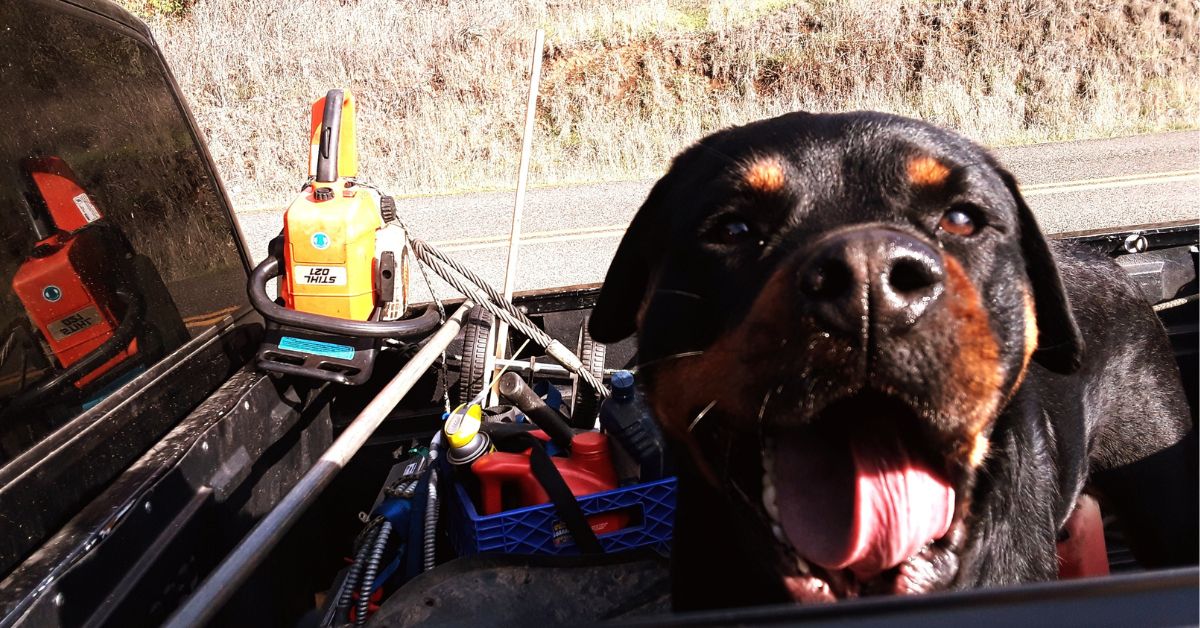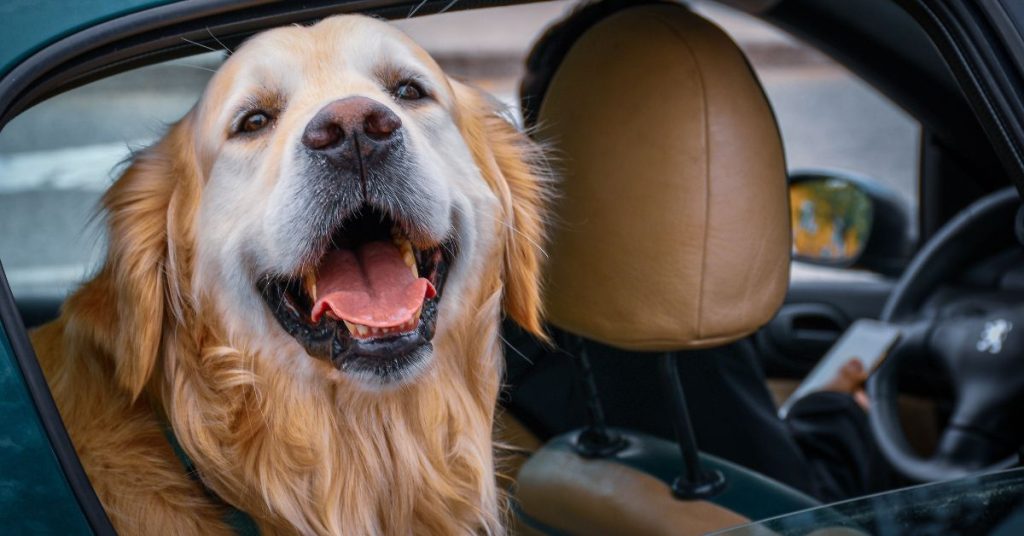Why does your dog start barking as soon as you get on the road? Whether it’s a short trip to the park or a long drive, car rides can be noisy. Traveling with your dog can be made more enjoyable if you understand the reasons behind his barking in the car. Different factors can trigger this behavior, ranging from excitement to anxiety to boredom. In this post, we’ll explore the common reasons why does my dog bark in the car, which will help you empathize and understand your dog. So, let’s dive in and uncover the reasons behind your dog’s barking in the car.
Why Does My Dog Bark in the Car?

It is essential to understand why does your dog bark in the car so that you can effectively address and manage this behavior. The following are some of the most common reasons:
Excitement
Dogs often associate car rides with exciting destinations like parks, beaches, or friends’ houses. The anticipation of these enjoyable outings can make dogs overly enthusiastic. As soon as they realize they are going for a ride, they may start barking.
Barking like this usually comes with other signs of excitement, like wagging tails, jumping up and down, and an overall lively attitude. Dogs can also pace back and forth or look out the window eagerly, making things even noisier.
Anxiety or Fear
On the other hand, some dogs may experience significant anxiety and stress during car rides. The unfamiliar motion, the engine noise, and the strange sights passing by quickly can cause anxiety.
Besides barking, dogs with anxiety may show signs like excessive panting, drooling, shaking, or even vomiting. They might try to hide or seek comfort from their owners, indicating their discomfort. It is often high-pitched and persistent, reflecting their distress.
Territorial Behavior
Natural territorial animals and dogs may perceive the car as an extension of their territory. Territorial instincts make them bark at anything they see as a threat, including cars, pedestrians, and cyclists.
Usually, this protective behavior involves a deeper, more assertive bark. Territorial dogs will also growl, show their teeth, or adopt a stiff posture as they bark, signaling their readiness to defend.
Boredom or Frustration
Long car rides can become monotonous for dogs, leading to boredom or frustration. Without enough stimulation, dogs may bark to entertain themselves or to express frustration.
Symptoms of boredom include restlessness, frequent looking out the window, and attempts to attract the attention of their owners. Often, boredom barking comes with other behaviors like chewing on seatbelts, whining, or pacing back and forth.
Attention-Seeking
It is common for dogs to seek their owner’s attention during car rides, especially when they feel neglected. Barking is a surefire way to get noticed when a dog feels ignored or wants something from the owner.
Besides barking, attention-seeking dogs paw at the owner, whine, and try to climb into the front seat. Dogs who get attention or reassurance from their owners may stop barking intermittently.
If you understand why does your dog bark in the car, you’ll be able to empathize with him and make the ride more pleasant.
Additional Tips for Traveling with Dogs in Car
Understanding why your dog barks in the car is not enough to make your ride smooth and enjoyable. To make your travels safer and more comfortable, follow these tips:
Safety Measures
Safety should always be a top priority when traveling with your dog. Properly restraining your dog in the car is important to avoid injuries in the event of sudden stops or accidents.
Consider using a dog seat belt, harness, or pet carrier to keep your dog secure. These restraints protect your dog and reduce distractions for the driver.
Regular Breaks
Regular breaks are essential for your dog during long trips. You should stop every couple of hours so your dog can stretch out, go to the bathroom, and burn off some energy. These breaks can reduce boredom-induced restlessness and barking. Please keep your dog on a leash during these stops to ensure their safety.
Hydration and Comfort
It is essential to keep your dog hydrated, especially during long car rides. Provide your dog with plenty of water at regular intervals. Additionally, maintaining a comfortable temperature inside the car is crucial. You should never leave your dog in a hot or cold car, as extreme temperatures can be dangerous. You can also help your dog feel more at ease by providing them with familiar items like a blanket or toy.
These tips can help you and your dog have a better travel experience. Prioritizing safety, regular breaks and comfort can keep your dog calm and happy.
Why Is My Dog Aggressive in the Car?

Aggressive behavior in the car is not uncommon, and it is often related to guarding. Dogs can be protective of almost any space, and the enclosed environment of a car can amplify this.
When your dog is with you in the car, he may feel the need to guard you and the vehicle from perceived threats. This protective behavior can manifest as aggression. You can manage your dog’s reactions and create a calmer car ride if you understand this.
FAQs
Is it normal for dogs to bark at cars?
Yes, it’s relatively common for dogs to bark at cars. There are several reasons why dogs bark at cars, including excitement, fear, territorial instincts, or being startled. As a form of attention-seeking behavior or frustration, some dogs may bark at cars.
Occasionally, barking at cars isn’t a problem, but excessive or intense barking could indicate underlying anxiety or aggression. Understanding the reasons behind your dog’s behavior can help address potential issues and improve its car ride.
How do I calm my dog down in the car?
Calming your dog down in the car involves several strategies:
- Positive Association: Introduce short, enjoyable rides to fun destinations.
- Comfort and Familiarity: Bring familiar items like blankets or toys into the car.
- Desensitization: Gradually expose your dog to car-related stimuli with rewards.
- Training: Practice obedience commands and relaxation techniques in the vehicle.
- Distraction: Provide interactive toys or treats to keep your dog occupied.
- Seek Professional Help: Consult a professional trainer or behaviorist if needed.
Why do dogs bark at car wheels?
Whenever they hear or see wheels or tires, dogs bark and run as a result of their natural prey drive. Their instincts compel them to chase moving objects, especially when they are threatened.
There are some dogs with a stronger prey drive than others, and the speed of moving objects can amplify it. When the wheels rotate and make noise, it can stimulate the dog’s prey drive, which leads to barking and engagement.
Is Car Anxiety Bad for Dogs?
Yes, car anxiety can significantly impact dogs’ well-being and quality of life. Dogs with car anxiety experience fear or stress when going for a drive, a common issue among many canines. Desensitization and counterconditioning are often used in combination with medication to treat this condition.
Using these methods, dogs gradually become more comfortable with car rides by associating positive experiences with them. Addressing car anxiety promptly and effectively is essential to preventing behavioral issues that may develop over time.
The Takeaway
If you understand why dogs bark in the car and address their anxieties or excitability, you’ll have a safer and more enjoyable ride. If you apply the tips discussed and seek professional guidance when necessary, your dog will feel more comfortable and relaxed during car rides.




